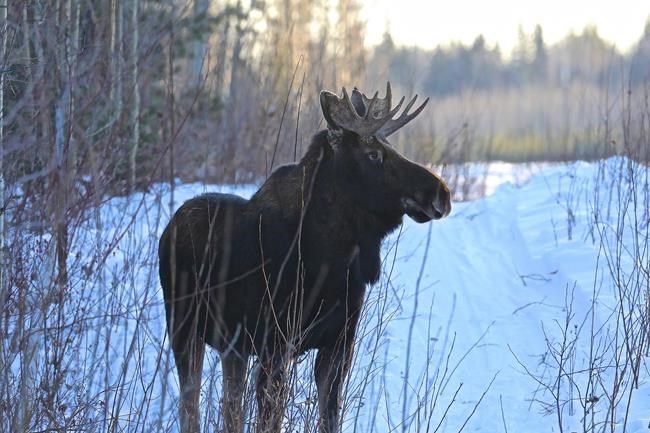PRINCE GEORGE, B.C. — A bull moose that mysteriously arrived inside the fenced perimeter at the airport in Prince George, B.C., ended up staying for weeks after finding itself alone in what an animal researcher says was an untouched "Garden of Eden."
It took a joint effort involving conservation officers, airport rescue crews and university scientists to coax the moose through an open gate after the animal spent several weeks at the airport feasting on fresh tree growth, said Roy Rea, a University of Northern B.C. ecosystem science researcher.
The young bull never came near the airport runway, but it had to be moved out for the safety of airport operations and the animal itself, Rea said in a recent interview.
"He was hanging out along the fence line over by the bush," he said. "We kept an eye on him and made sure he wasn't going to create a danger. If that was going to happen, we were going to have to destroy him, but he wasn't, so we worked to try and figure out a solution."
The Prince George Airport is located about five kilometres southeast of the city and includes a forested area within its fenced perimeter of about 10 hectares.
Rea said it is not known how the moose got onto the airport grounds, but it's suspected a recent storm blew open an unlocked gate and the moose walked through.
Once inside the fence, the moose found itself in a forested area of newly grown trees it would consider a "Garden of Eden," he said.
"Nothing's been eaten in there for a while, so it was a real cornucopia of things for him to eat," said Rea, describing a bounty of red-osier dogwood and willow branches.
"The current growth from last summer gets gobbled up pretty quick by the elk and the deer and the moose, but inside the airport, it's not been eaten by anything because it's all fenced off," he said.
However, Rea said there were signs the moose wanted to leave.
"While there was plenty of food to eat and he was safe from the wolves, I think he probably wanted to get back out because you could see his tracks up and down the fence line trying to figure out how to get out."
A camera-grid system Rea has had at the airport since 2007 to document wildlife in the forested area alerted him to the presence of the moose.
The animal was spotted in late November and wasn't convinced to leave until January, but it was only this month that the researchers revealed their wrangling success.
"When the cameras picked up where he was, we got guys in position and moved them to the area, opened up the fence and then we just allowed the moose to just keep wandering down the fence line and out the gate," Rea said.
He said the cameras often photograph hawks, owls and eagles hunting in the forest and there's evidence of bears and coyotes digging under the fence to get in, but they stay away from the runway because it's wide open and unprotected.
In March 2015, a small aircraft with two people on board hit and killed a moose that appeared from behind a snowbank on the runway of the airport in nearby Fort St. James.
Rea said successfully getting the young bull from the airport and back to the wilderness gives the animal a chance to increase declining moose numbers.
"Our moose populations here in northern B.C. are down 70 per cent and the population is really struggling," he said. "This is a prime bull. There's not enough bulls out there doing the breeding and every time you can save a bull, it keeps him in the breeding population."
— By Dirk Meissner in Victoria.
This report by The Canadian Press was first published March 9, 2021.
The Canadian Press



